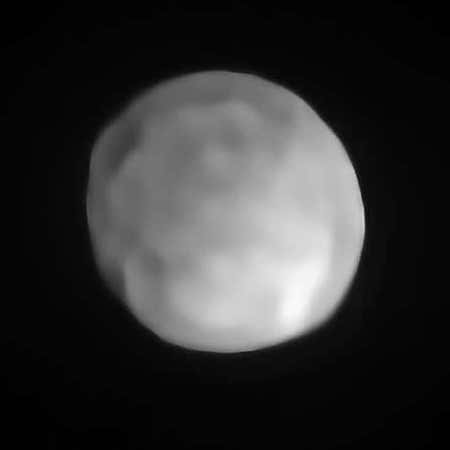Smallest spherical planet so far found

A new image of the asteroid Hygiea has revealed that this main belt object is actually spherical, making it the smallest spherical asteroid so far discovered and suggesting that it could be defined as a planet.
The image, taken by the Very Large Telescope (VLT) in Chile, is to the right. The asteroid was first discovered in 1849 and is the fourth largest in the asteroid belt, after Ceres, Pallas, and Vesta, with a diameter of 267 miles.
The image once again challenges the definition of what makes a planet. It also makes difficult the vague term “dwarf planet.” At what point does a dwarf become a full planet? This has never been clarified, which is why I tend to avoid using the term dwarf planet.
In my many interviews of planetary scientists, they generally dismiss the IAU’s poor definition of a planet and define a planet as anything that has settled into a spherical shape. In the case of Hygiea, that seems to apply.
On Christmas Eve 1968 three Americans became the first humans to visit another world. What they did to celebrate was unexpected and profound, and will be remembered throughout all human history. Genesis: the Story of Apollo 8, Robert Zimmerman's classic history of humanity's first journey to another world, tells that story, and it is now available as both an ebook and an audiobook, both with a foreword by Valerie Anders and a new introduction by Robert Zimmerman.
The print edition can be purchased at Amazon or from any other book seller. If you want an autographed copy the price is $60 for the hardback and $45 for the paperback, plus $8 shipping for each. Go here for purchasing details. The ebook is available everywhere for $5.99 (before discount) at amazon, or direct from my ebook publisher, ebookit. If you buy it from ebookit you don't support the big tech companies and the author gets a bigger cut much sooner.
The audiobook is also available at all these vendors, and is also free with a 30-day trial membership to Audible.
"Not simply about one mission, [Genesis] is also the history of America's quest for the moon... Zimmerman has done a masterful job of tying disparate events together into a solid account of one of America's greatest human triumphs."--San Antonio Express-News

A new image of the asteroid Hygiea has revealed that this main belt object is actually spherical, making it the smallest spherical asteroid so far discovered and suggesting that it could be defined as a planet.
The image, taken by the Very Large Telescope (VLT) in Chile, is to the right. The asteroid was first discovered in 1849 and is the fourth largest in the asteroid belt, after Ceres, Pallas, and Vesta, with a diameter of 267 miles.
The image once again challenges the definition of what makes a planet. It also makes difficult the vague term “dwarf planet.” At what point does a dwarf become a full planet? This has never been clarified, which is why I tend to avoid using the term dwarf planet.
In my many interviews of planetary scientists, they generally dismiss the IAU’s poor definition of a planet and define a planet as anything that has settled into a spherical shape. In the case of Hygiea, that seems to apply.
On Christmas Eve 1968 three Americans became the first humans to visit another world. What they did to celebrate was unexpected and profound, and will be remembered throughout all human history. Genesis: the Story of Apollo 8, Robert Zimmerman's classic history of humanity's first journey to another world, tells that story, and it is now available as both an ebook and an audiobook, both with a foreword by Valerie Anders and a new introduction by Robert Zimmerman.
The print edition can be purchased at Amazon or from any other book seller. If you want an autographed copy the price is $60 for the hardback and $45 for the paperback, plus $8 shipping for each. Go here for purchasing details. The ebook is available everywhere for $5.99 (before discount) at amazon, or direct from my ebook publisher, ebookit. If you buy it from ebookit you don't support the big tech companies and the author gets a bigger cut much sooner.
The audiobook is also available at all these vendors, and is also free with a 30-day trial membership to Audible.
"Not simply about one mission, [Genesis] is also the history of America's quest for the moon... Zimmerman has done a masterful job of tying disparate events together into a solid account of one of America's greatest human triumphs."--San Antonio Express-News


From the looks of things, it must be close to the point where there isn’t enough mass to cause enough gravity to result in a spherical object. Perhaps when we determine that we will know the lower limit of a “planet”
Hi Bob
This article
https://newatlas.com/space/large-asteroid-hygiea-dwarf-planet/
Mentioned the IAU requirements for planet and dwarf planet
For both
Orbit the sun
Large enough to have coalesced into a spherical shape
Not a moon
To be a planet and not a dwarf planet
Cleared its orbit of debris
Chris: I am well aware of the IAU’s definition. I also know that it makes no sense, and is worthless. And all my comments are reinforced by what planetary scientists have told me.
Looks a little like the Death Star.
Everything round is a planetoid.
Call something a sun if it gives off detectable light.
Call something a planet if it is a planetoid and it orbits a sun.
Call something a moon if it orbits a planet.
Other objects can have names like asteroids or comets or pretty much anything you like.
Call something a moon if it orbits a planet.
Should be
Call something a moon if it is a planetoid and it orbits a planet.